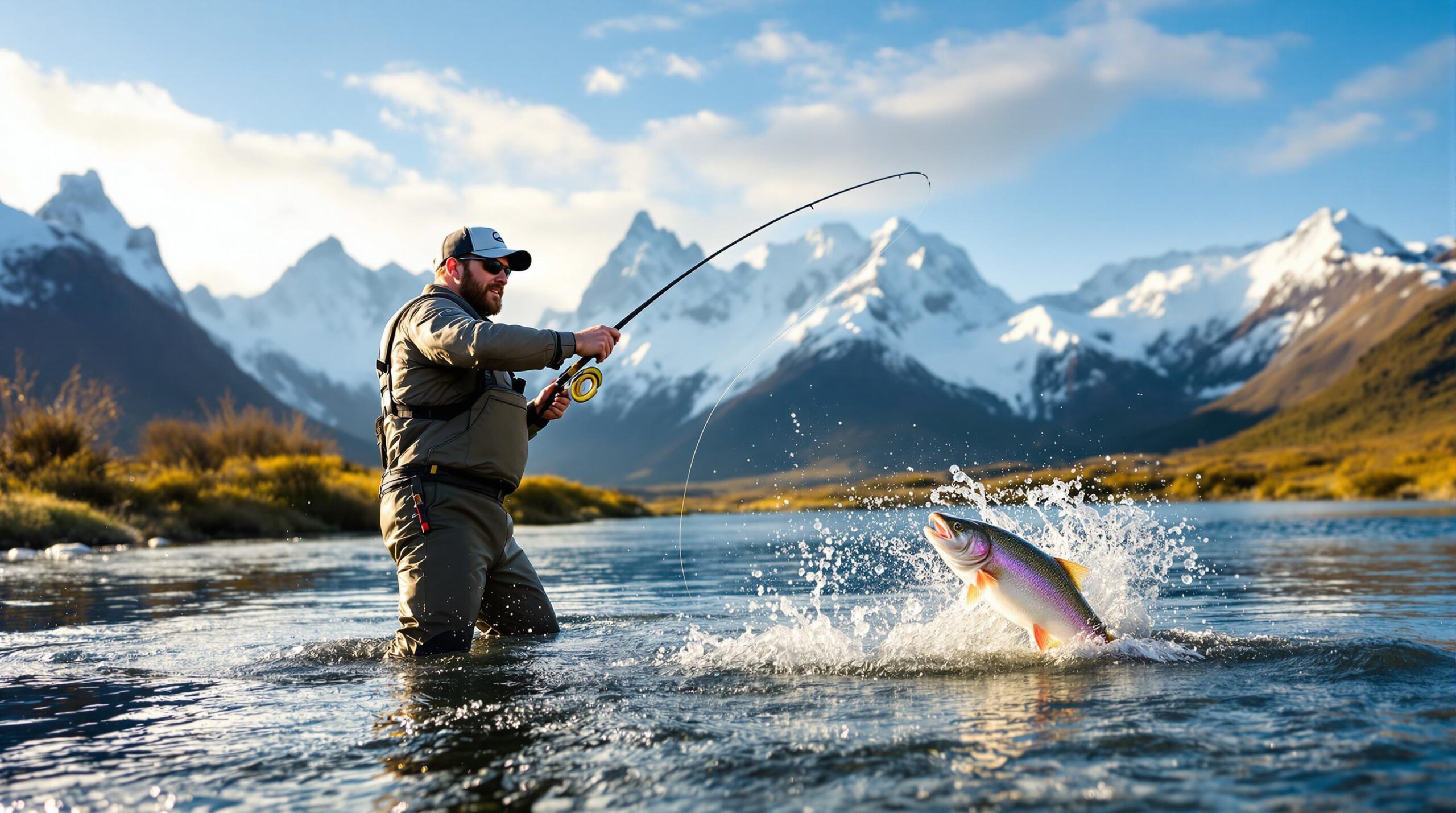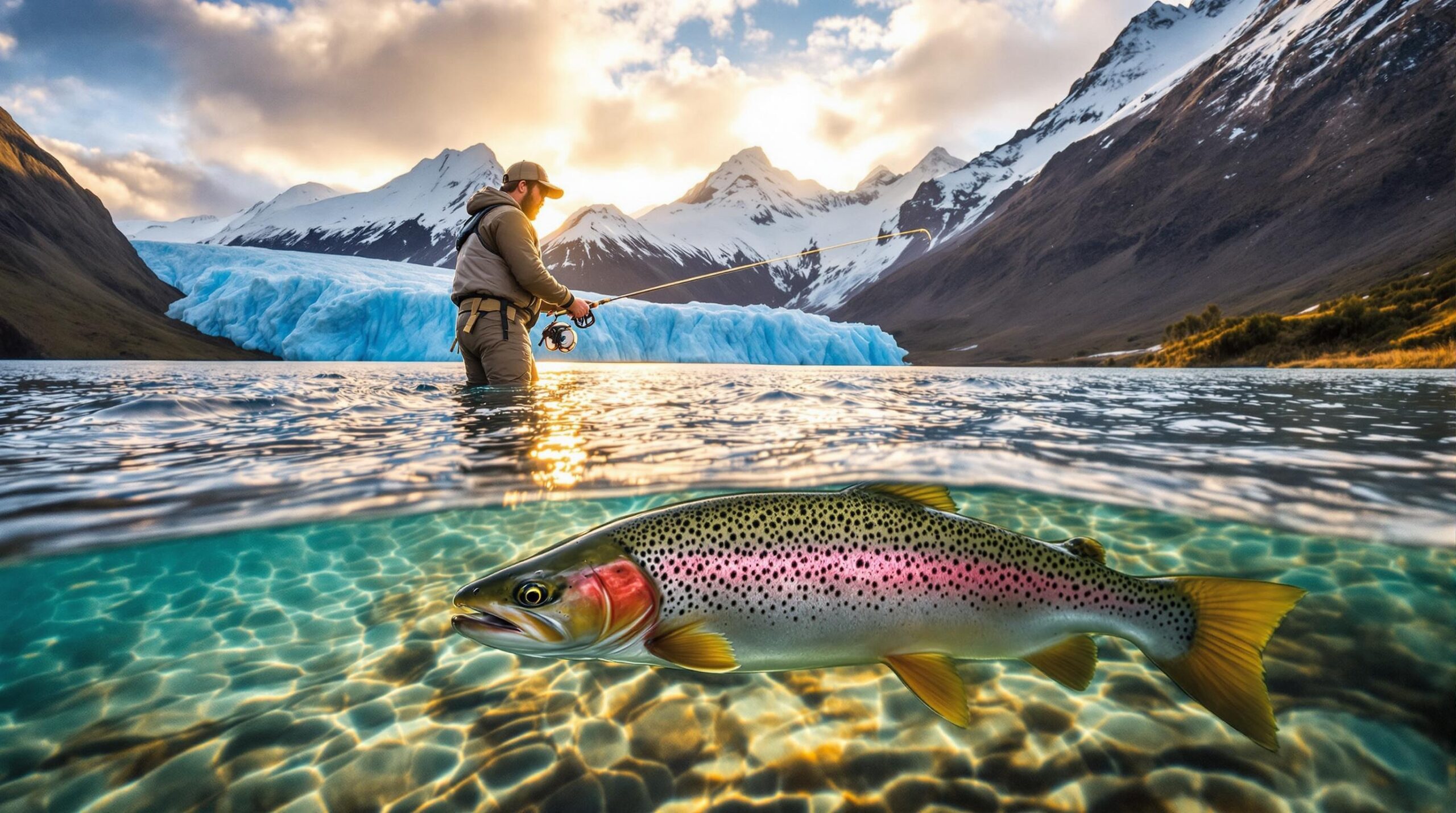According to Travel Weekly, Argentina’s fly fishing tourism generates over $200 million annually. Patagonia hosts some of the world’s most exclusive angling destinations, where rainbow trout, brown trout, and brook trout thrive in pristine waters that remain largely untouched by commercial fishing pressure. The region’s premier fly fishing lodges Argentina offers provide world-class accommodations and expert guides, positioning themselves as gateways to some of the most productive and scenic trout waters on the planet.
Key Takeaways
- Argentina’s Patagonia region hosts over 50 premium lodges specializing in world-class fly fishing experiences
- Peak season runs from November through April when water temperatures and insect hatches are optimal
- Trophy trout weighing 8-15 pounds are commonly caught in Patagonian rivers and lakes
- Most lodges offer all-inclusive packages including guided fishing, meals, and luxury accommodations
- Remote locations require advance booking with many lodges filling up 12-18 months ahead
Elite Patagonian Lodges: Where Luxury Meets Wilderness
Patagonia’s fishing lodges represent the pinnacle of angling luxury. These establishments combine world-class fishing with exceptional hospitality in some of Earth’s most remote wilderness areas.
Estancia Tecka stands as one of the region’s most prestigious destinations. This 50,000-acre working ranch offers access to over 30 miles of private river fishing. The lodge accommodates just 12 guests at a time, ensuring personalized service and uncrowded waters.
Nervous Waters Lodge occupies a similarly elite position in the Limay River valley. This operation provides access to spring creeks where 20-inch rainbow trout are common rather than exceptional. The lodge’s architecture mirrors traditional Patagonian estancia style while incorporating modern amenities.
Luxury Accommodations in Remote Wilderness
The region’s top lodges redefine luxury in wilderness settings. Accommodations range from rustic elegance to contemporary sophistication, all designed to complement the natural environment.
Tipiliuke Lodge exemplifies this approach with eight rooms featuring panoramic views of Lago Strobel. Heated floors and quality linens ensure comfort after long days on the water. The lodge’s restaurant sources ingredients locally, creating menus that celebrate regional flavors.
Kau Tapen Lodge takes a different approach with safari-style tents equipped with private bathrooms and heating systems. This unique accommodation style places guests closer to nature while maintaining expected comfort standards.
Distinguished Amenities at Top Lodges
These establishments consistently provide amenities that separate them from standard fishing outfitters:
- Private chefs specializing in Argentine cuisine and fresh local ingredients
- Equipment rooms stocked with quality rods, reels, and flies
- Heated drying rooms for waders and fishing gear
- Wine cellars featuring Argentina’s finest vintages
- Massage therapy and spa services
- Private airstrips for helicopter and small aircraft access
Professional Guide Services and Fishing Programs
Professional guide services distinguish top operations from basic fishing camps. These guides possess intimate knowledge of local waters, seasonal patterns, and effective techniques for Patagonian conditions.
Jurassic Lake Lodge employs guides with decades of experience on their specific waters. Each guide maintains detailed logs of fishing conditions, successful patterns, and seasonal variations. This data-driven approach consistently produces strong results for guests.
The guide-to-guest ratio at top lodges rarely exceeds 1:2, ensuring personalized instruction and maximum fishing opportunities. Many operations offer specialized programs for different skill levels, from beginning fly fishers to tournament competitors.
Fishing Techniques and Target Species
Patagonian waters support diverse fishing opportunities throughout the season. Fly fishing in Patagonia requires adaptation to local conditions and species behavior.
Rainbow trout dominate most waters, with specimens regularly exceeding 20 inches. Brown trout populations include both stream-resident fish and lake-run specimens that can reach 30 inches or more. Brook trout, while less common, provide exciting opportunities in high-altitude streams.
Seasonal Timing for Optimal Fishing
Timing plays a crucial role in Patagonian fishing success. The southern hemisphere seasons create unique opportunities and challenges for visiting anglers.
Early season (November-December) offers dry fly fishing as terrestrial insects become active. Grasshopper patterns produce explosive strikes from aggressive trout. Water levels remain stable, and weather conditions are generally mild.
Mid-season (January-February) brings peak summer conditions. Longer daylight hours extend fishing opportunities, while warm temperatures encourage surface feeding. This period coincides with the height of the terrestrial season.
Late season (March-April) provides some of the year’s best fishing. Cooling temperatures trigger aggressive feeding behavior as trout prepare for winter. Fall colors create spectacular scenery, and reduced fishing pressure means more solitude on the water.
Weather Patterns and Fishing Conditions
Patagonian weather can change rapidly, requiring flexible fishing strategies. Patagonia fly fishing guide services understand these patterns and adjust daily plans accordingly.
Wind represents the most significant weather factor. Patagonian winds can reach 40+ mph, making casting difficult and sometimes dangerous. Top lodges maintain alternative fishing locations protected from prevailing winds.
Understanding Your Lodge Options
The abundance of Patagonian fishing lodges creates both opportunities and challenges for visiting anglers. Each operation offers distinct advantages based on location, target species, and fishing style preferences.
Geographic considerations significantly impact the fishing experience. Northern Patagonia lodges, centered around Bariloche and San Martin de los Andes, offer convenient access from Buenos Aires. These operations typically focus on river fishing with occasional lake opportunities.
Southern Patagonia lodges, particularly those in Santa Cruz province, provide access to legendary waters like Jurassic Lake and Lago Strobel. These destinations require additional travel time but offer fishing opportunities unavailable elsewhere in the world.
The choice between river and lake fishing influences lodge selection. River-focused operations provide classic fly fishing experiences with diverse water types, from spring creeks to freestone rivers. Lake lodges offer opportunities for trophy hunting, with sea-run trout and massive resident fish.
Specialized Programs and Fishing Styles
Advanced Patagonian lodges develop specialized programs catering to specific angling interests. These programs demonstrate the depth of expertise available at top operations.
Sight fishing programs focus on visual hunting of individual fish. Guides use elevated positions and polarized optics to locate feeding trout, then position anglers for precise presentations. This technique proves particularly effective on spring creeks and clear lakes.
Streamer fishing programs target the largest trout using baitfish imitations. These techniques require specialized equipment and casting skills but produce the most trophy-sized fish. Some lodges dedicate specific days or weeks to streamer fishing exclusively.
Technical dry fly programs emphasize precision casting and pattern selection. These programs often include fly tying instruction, teaching guests to create effective local patterns. The focus on technique development appeals to serious fly fishers seeking skill improvement.
Travel Logistics and Planning
Successful Patagonian fishing trips require careful planning and attention to logistical details. The remote locations and seasonal nature of these operations demand advance preparation.
International travel to Argentina involves specific requirements and considerations. Most visitors require a valid passport but no visa for stays under 90 days. Health requirements may include vaccinations depending on your country of origin and specific destinations within Argentina.
Domestic travel within Argentina often involves multiple flights and ground transportation. Buenos Aires serves as the primary international gateway, with connections to regional airports like Bariloche, Esquel, and El Calafate. Some lodges provide charter aircraft services for direct access to remote locations.
Equipment considerations extend beyond standard fly fishing gear. Patagonian conditions require specific adaptations, including wind-resistant clothing, high-quality rain gear, and sun protection. Many lodges provide equipment lists tailored to their specific locations and seasons.
Booking and Reservation Strategies
Securing reservations at top Patagonian lodges requires strategic planning and flexibility. The most prestigious operations maintain waiting lists for prime dates, particularly during peak season.
Booking timelines vary significantly among lodges. Established operations with strong reputations often require 12-18 months advance notice for preferred dates. Newer lodges or those expanding capacity may offer more flexible booking windows.
Group bookings provide advantages for parties of 4-8 anglers. Many lodges offer group discounts and can customize programs for specific interests or skill levels. Corporate groups and fishing clubs often receive preferential treatment for large bookings.
Last-minute opportunities occasionally arise due to cancellations or weather-related schedule changes. Maintaining relationships with lodge operators and booking agents can provide access to these unexpected openings.
Cultural Immersion and Local Experiences
Top Patagonian fishing lodges offer more than angling opportunities. These establishments serve as gateways to Patagonian culture, history, and natural wonders.
Gaucho culture remains central to Patagonian identity. Many lodges incorporate traditional elements into their operations, from architectural styles to culinary traditions. Guests often participate in ranch activities, including horseback riding and livestock demonstrations.
Wine experiences complement the fishing programs at many lodges. Argentina’s wine regions produce world-class vintages, and many operations maintain extensive cellars featuring local selections. Wine tastings and vineyard visits add cultural depth to fishing trips.
Historical sites and natural landmarks provide opportunities for exploration during non-fishing periods. Perito Moreno Glacier, Cueva de las Manos, and various national parks offer world-class sightseeing within reasonable distances of major fishing lodges.
Culinary Experiences
Argentine cuisine extends far beyond the country’s famous beef. Patagonian lodges showcase regional specialties that reflect local ingredients and cultural influences.
Lamb represents a Patagonian staple, often prepared using traditional asado techniques. Lodge chefs combine time-honored cooking methods with contemporary presentation, creating memorable dining experiences. Fresh trout, when regulations permit, provides another local protein option.
Indigenous ingredients add unique flavors to lodge menus. Calafate berries, nalca (wild rhubarb), and various wild mushrooms appear in both traditional and innovative preparations. These ingredients connect guests to the landscape in meaningful ways.
Cooking classes and food experiences allow guests to learn traditional techniques. Some lodges offer hands-on asado instruction, teaching the art of Argentine barbecue. These activities provide valuable cultural insights while creating lasting memories.
Conservation and Sustainability Initiatives
Leading Patagonian lodges recognize their responsibility as stewards of local ecosystems. Conservation programs protect the natural resources that sustain both fishing opportunities and local communities.
Catch-and-release practices form the foundation of sustainable fishing programs. Most lodges enforce strict catch-and-release policies, particularly for native species. These practices ensure healthy fish populations for future generations while maintaining the sporting challenge anglers seek.
Habitat restoration projects demonstrate long-term commitment to environmental stewardship. Lodges invest in stream improvement, invasive species control, and habitat enhancement projects. These efforts often extend beyond lodge boundaries to benefit entire watersheds.
Research partnerships with universities and conservation organizations advance scientific understanding of Patagonian ecosystems. Lodge operators contribute data, funding, and logistical support for research projects. This collaboration benefits both conservation efforts and fishing programs.
Community Engagement and Economic Impact
Responsible Patagonian lodges contribute significantly to local communities through employment, purchasing, and infrastructure development. These economic impacts extend far beyond the fishing industry itself.
Employment opportunities include guides, cooks, housekeepers, maintenance staff, and transportation providers. Many lodges prioritize hiring local residents, providing training and career development opportunities. These positions often offer higher wages than alternative employment options.
Local sourcing programs support regional farmers, ranchers, and artisans. Lodges purchase meat, vegetables, crafts, and services from nearby communities. This economic activity helps sustain rural populations in remote areas.
Infrastructure investments benefit entire regions. Lodge construction and maintenance projects improve road access, communication systems, and utility services. These improvements benefit both lodge operations and local communities.
Making the Right Choice for Your Trip
The diversity of Patagonian fishing lodges creates both opportunities and challenges for discerning anglers. Understanding the key differentiators helps ensure the best possible experience for your specific interests and expectations.
Location represents the most fundamental consideration. Fly fishing lodges in Patagonia Argentina span vast distances, from lake district operations in the north to southern ice field destinations. Each region offers distinct fishing opportunities and experiences.
Northern locations provide easier access and more diverse fishing options. Rivers like the Chimehuin, Malleo, and Quilquihue offer classic dry fly fishing for rainbow and brown trout. Lake Nahuel Huapi and surrounding waters provide opportunities for large fish using streamer techniques.
Southern destinations excel in trophy fishing opportunities. Jurassic Lake, Lago Strobel, and associated waters produce trout of size and quality unavailable elsewhere. These locations require additional travel time but offer fishing experiences worth the extra effort.
Accommodation styles vary significantly among operations. Traditional estancia-style lodges emphasize rustic elegance and local cultural elements. Contemporary facilities offer modern amenities while maintaining connection to the natural environment. Some operations provide unique accommodation options like luxury tents or floating lodges.
Evaluating Service Quality and Expertise
Service quality distinguishes the best Patagonian lodges from standard operations. Evaluating these factors requires understanding the elements that contribute to superior guest experiences.
Guide quality represents perhaps the most critical factor. The best guides possess intimate knowledge of local waters, seasonal patterns, and effective techniques. They adapt instruction to individual skill levels while maintaining safety standards. The best guides become fishing partners rather than mere service providers.
Equipment quality affects both fishing success and safety. Top lodges maintain current, well-maintained tackle suitable for local conditions. Backup equipment ensures continued fishing despite equipment failures. Some operations provide custom rod and reel setups tailored to specific fishing situations.
Attention to detail separates good lodges from great ones. This includes everything from properly heated rooms to perfectly prepared meals. Small touches like heated waders, quality rain gear, and thoughtful amenities demonstrate commitment to guest comfort.
Flexibility in program design accommodates varying weather conditions and guest preferences. Superior operations maintain alternative fishing locations and backup plans for challenging conditions. This adaptability ensures productive fishing regardless of circumstances.
Advanced Techniques and Specialized Programs
Elite Patagonian lodges offer specialized programs that push the boundaries of traditional angling. These advanced techniques require specific skills and equipment but produce results for dedicated practitioners.
Mouse fishing represents one of the most exciting specialized techniques. Large trout aggressively attack mouse patterns during evening hours, creating explosive surface strikes. This technique requires specialized casting skills and nerves of steel but produces unforgettable fishing experiences.
Streamer fishing programs focus on hunting the largest trout using baitfish imitations. These techniques involve casting large flies with heavy rods, often in challenging wind conditions. Success requires physical stamina and technical skill but produces trophy-sized fish.
Technical nymphing programs emphasize precise presentation of subsurface flies. These techniques require specialized equipment and advanced casting skills but prove highly effective when surface feeding is limited. European nymphing methods have gained popularity in Patagonian waters.
Spey casting instruction provides tools for handling large rivers and windy conditions. Two-handed rods excel in Patagonian environments, allowing efficient casting with large flies. Many lodges offer specialized spey casting instruction and equipment.
Equipment Considerations for Advanced Techniques
Specialized fishing techniques require specific equipment configurations. Understanding these requirements helps anglers prepare properly for advanced programs.
Streamer fishing demands heavy rods capable of casting large flies in windy conditions. Seven to eight-weight rods represent the minimum for serious streamer work. Sink-tip lines and strong tippets handle the demands of fishing with large, weighted flies.
Technical dry fly fishing requires precision casting equipment. Longer rods provide better line control and presentation accuracy. High-quality reels with smooth drags become essential when fighting large trout on light tippets.
Variable fishing conditions demand versatile equipment setups. Many experienced anglers travel with multiple rod and reel combinations to handle different techniques and conditions. Lodge equipment programs often provide access to specialized setups without the need for extensive personal equipment.
Future Trends and Developments
The Patagonian lodge industry continues evolving to meet changing guest expectations and environmental challenges. Understanding these trends helps predict future developments and opportunities.
Sustainability initiatives will likely become more prominent as environmental awareness increases. Lodges are investing in renewable energy systems, waste reduction programs, and carbon offset initiatives. These efforts appeal to environmentally conscious travelers while reducing operational costs.
Technology integration enhances both fishing effectiveness and guest experiences. GPS fish finders, underwater cameras, and weather monitoring systems provide valuable information for guides and guests. Communication systems improve safety and coordination in remote locations.
Customization and personalization represent growing trends in luxury travel. Lodges are developing more flexible programs that accommodate individual preferences and skill levels. Private guides, custom itineraries, and specialized instruction become more common.
Accessibility improvements make Patagonian fishing available to broader audiences. Some lodges are developing programs for anglers with disabilities or physical limitations. These initiatives expand the potential guest base while maintaining high-quality experiences.
Emerging Destinations and Opportunities
New Patagonian lodges continue developing as operators discover previously unexplored waters. These emerging destinations offer opportunities for pioneering anglers seeking unique experiences.
Remote locations in Tierra del Fuego and southern Chile provide access to pristine waters with minimal fishing pressure. These destinations require additional travel time and costs but offer unparalleled wilderness experiences.
Private access arrangements create fishing opportunities on previously unavailable waters. Some lodges negotiate access to private ranches or remote locations through helicopter or boat transport. These arrangements provide unique fishing experiences unavailable through traditional channels.
Multi-location programs combine fishing with other outdoor activities. Some operators offer combination packages including fishing, hiking, wildlife viewing, and cultural experiences. These programs appeal to travelers seeking diverse Patagonian experiences.
Frequently Asked Questions
What’s the best time to visit Argentina’s fishing lodges?
Peak season runs November through April, with January-February offering the warmest weather and longest days. Early season provides dry fly fishing while late season brings aggressive pre-winter feeding.
How far in advance should I book?
Top lodges require 12-18 months advance booking for prime dates. Popular operations maintain waiting lists, so early booking ensures preferred dates and accommodations.
What size trout can I expect?
Rainbow trout average 16-20 inches with specimens exceeding 24 inches common. Brown trout run larger, with 20-25 inch fish typical and trophy specimens reaching 30+ inches in select waters.
Do lodges provide equipment?
Most lodges provide high-quality rods, reels, and flies suitable for local conditions. However, many experienced anglers prefer bringing personal equipment for familiarity and specific preferences.
What’s included in lodge packages?
All-inclusive packages typically cover accommodation, meals, guided fishing, equipment, and ground transportation. International flights, alcoholic beverages, and gratuities are usually additional.
Are these lodges suitable for beginners?
Many lodges offer programs specifically designed for beginning anglers, including casting instruction and basic technique development. However, some operations focus on experienced anglers.
Sources:
Argentine Ministry of Tourism
Argentine Tourism Board
Fly Fishing Magazine
Patagonia Trout Foundation
Patagonia Lodge Association


